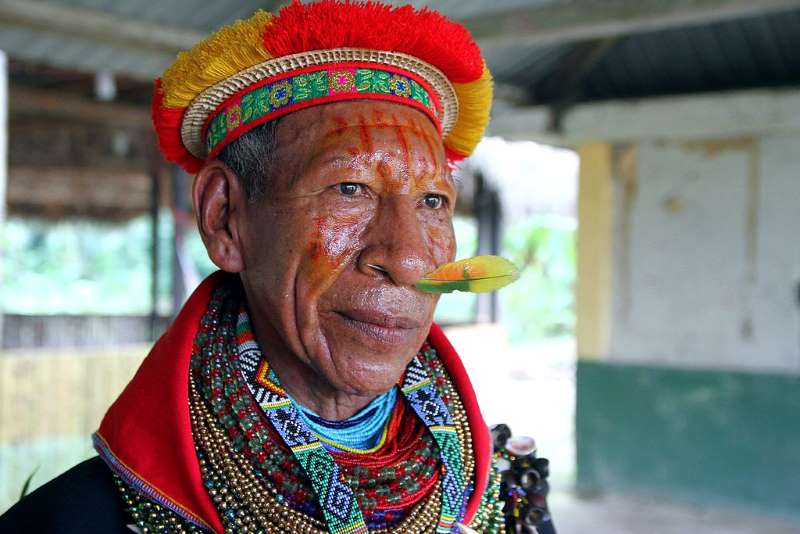
The Cofán, Kofán, Kofane or A’i, are an indigenous people living in the northwestern Amazon, being a transboundary people with binational presence in Colombia and Ecuador.
Cofan Territory
According to historical sources, the indigenous Cofán communities originating in the Lower Putumayo settled along the banks of the San Miguel River in Colombia and the Aguarico and Napo Rivers in Ecuador; however, they also have territory on the banks of the Amazonian Guamuéz and Rumiyaco Rivers (in Colombia) (Rubiano, 2017) (6).
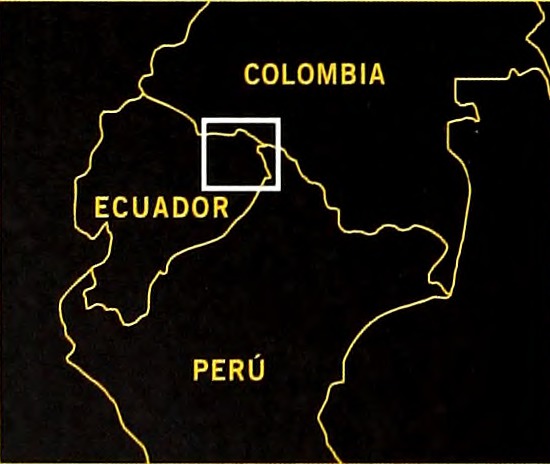
The territory occupied by the Cofán covers approximately 27,370.60 hectares, divided into nine settlements, which in turn are subdivided into seven resguardos, which are collective lands, and two cabildos. In Colombia, their territories are located in the municipalities of Puerto Asís, Orito, Valle del Guamuéz and San Miguel in the department of Putumayo, and Ipiales in the department of Nariño (Rubiano, 2017) (6). In Ecuador, the Cofán indigenous community is located in the province of Sucumbíos, in the northern Amazon region of the country.
Population
The results of the Colombian National Population and Housing Census (2018), more specifically the Indigenous Population Census, indicate that 1,816 indigenous people self-identified as belonging to the Cofán ethnic group (DANE, 2019) (1). On the other hand, approximately 1,485 individuals of this indigenous people are found in the Ecuadorian Amazon (IWGIA, April 24, 2019) (2).
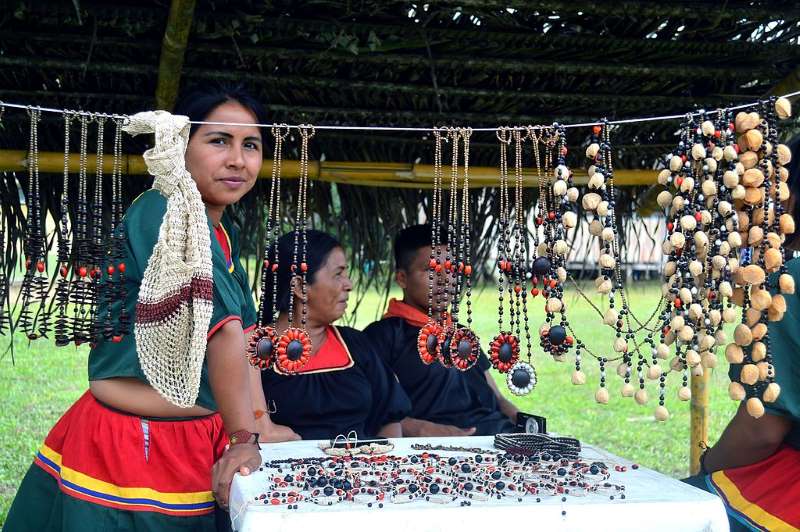
Cosmovision
The origin myth of the Cofán refers that the creator being Chiga or Sun God, erected the three levels of the world (subway, terrestrial and celestial), starting with kuankua (bottom level) and culminating with ufenyunyu (top level) (Rubiano, 2017) (6) (6). Thus, from the cosmology of the Cofán, the world is conceived considering three levels that form a systemic unity:
- Kuankua: corresponds to the third or lower level, where the owners of the animals and plants (called masters of nature) live, who through their wisdom and knowledge moved under the earth. Kuankua is found both below ground and underwater (Rubiano, 2017) (6).
- Ingi ande: is the intermediate level of the world, it is inhabited by human beings, as well as beings that are not visible to all humans, called ukabate, and become visible to shamans who take yagé and have initiated this learning process (Rubiano, 2017) (6).
- Ufenyunyu: is the upper level of the world, i.e. the world above, where beings that live in space, such as the sun, the moon, the stars, the stars and the rainbow, dwell (Rubiano, 2017) (6).
The cosmogony of the Cofán refers to the existence of spirits that determine the events on earth. These forces are controlled by the shaman through yagé and tobacco, as he possesses the knowledge to contact the spirits and interpret the visions provided by the sacred plants, as well as the ability to look into the future (Republic of Colombia, Ministry of the Interior, S.f.) (5). Likewise, the sun and the moon are sacred symbols of this culture.

Language
According to the National Indigenous Organization of Colombia, ONIC (S.f.) (3), the language of the Cofán -which is kept alive in most of the communities of this ethnic group- is called A’ingae, which has not been classified in any of the linguistic families. However, some studies consider it to be part of the Chibcha language and others relate it to Andean languages. It is spoken in the Amazonian department of Putumayo in Colombia and the provinces of Napo and Sucumbíos in Ecuador.
Socio-political organization
The Cofán have traditionally been organized in groups of patrilineal descent, led by the shaman as political and religious leader. Currently, the nuclear family constitutes the fundamental cell of their social organization as the basic unit of production and consumption, as well as socialization as members of the family and the community. However, the blood ties that bind them to extended families or lineages are important, given that the nuclear family alone generally cannot constitute an autonomous working group (Republic of Colombia, Consejería Presidencial para los Derechos Humanos, S.f.) (4).
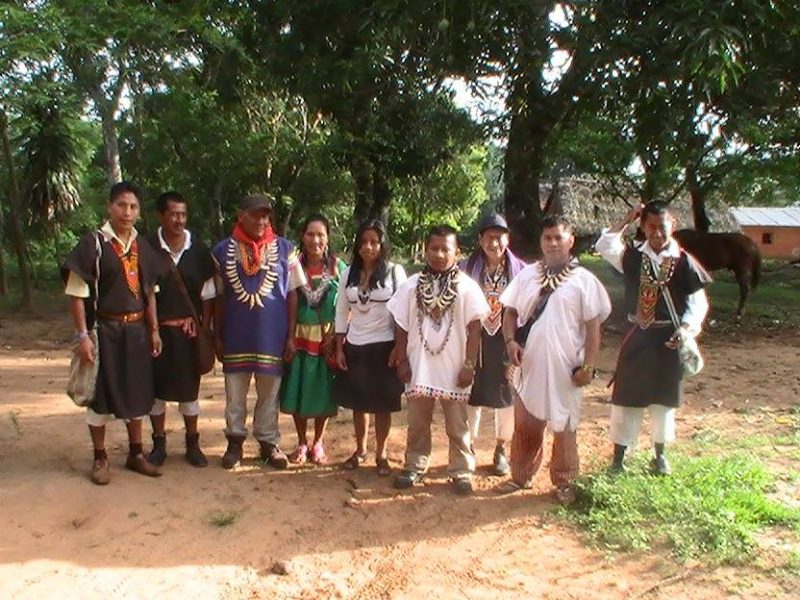
The traditional political organization of the Cofán, in force until the 1960s, was represented by the shaman or curaca, the politico-religious leader of this community based on his authority and civil and religious power to mediate between the forces of the natural and supernatural world. From the sixties onwards, the influence of the Capuchin missions, the boom of the colonization of the original territories of the Cofán and the death of the most renowned shamans, the Cabildo was established and strengthened as a system of political organization, promoting the separation of civil and religious powers, eventually relegating the role of the curaca to that of a doctor or traditional indigenous healer. Thus, a governor or captain and a secretary are elected annually in the community, whose main functions are to organize and direct communal activities and to act as representative before government authorities (República de Colombia, Consejería Presidencial para los Derechos Humanos, S.f.) (4).
Production system
The traditional economic practices of the Cofán communities are centered on subsistence gardening based on the slash-and-burn system, as well as hunting, fishing and gathering wild fruits. Likewise, with the expansion of colonization in this Amazon region, the Cofán ethnic group has been integrating into the regional market network based on some activities related to commercial agriculture, animal husbandry, timber exploitation and the production of handicrafts for sale. Thus, the main crops grown on the chagra for self-consumption, i.e. for family sustenance, are sweet cassava, bananas, fruit trees and medicinal plants, while cash crops (small surpluses destined for the regional market) are mainly corn and rice (Republic of Colombia, Consejería Presidencial para los Derechos Humanos, S.f.) (4).
References
- National Administrative Department of Statistics, DANE. 2019. Indigenous Population of Colombia. Results of the 2018 National Population and Housing Census. Retrieved from https://www.dane.gov.co/files/investigaciones/boletines/grupos-etnicos/presentacion-grupos-etnicos-2019.pdf.
- IWGIA. (April 24, 2019). Indigenous World 2019: Ecuador. Retrieved from https://www.iwgia.org/es/ecuador/3396-mi2019-ecuador.html.
3) National Organization of Indigenous People of Colombia, ONIC. S.f. Kofan. Retrieved from https://www.onic.org.co/pueblos/1114-kofan.
(4) Republic of Colombia, Consejería Presidencial para los Derechos Humanos. S.f. Diagnosis of the indigenous situation of the Kofán people. Retrieved from http://historico.derechoshumanos.gov.co/Observatorio/Documents/2010/DiagnosticoIndigenas/Diagnostico_KOFÁN.pdf.
(5) Republic of Colombia, Ministry of the Interior. S.f. Cofan. Retrieved from https://www.mininterior.gov.co/sites/default/files/upload/SIIC/PueblosIndigenas/pueblo_cof_n.pdf.
6) Rubiano Carvajal, J. C. 2017. The territory of the stars, of thea‘í, of theukabateand of thekuankua: the world and its occupants for the Cofán(a’i) of Putumayo. Boletín de Antropología, 33 (55), 35-55. Retrieved from https://www.redalyc.org/journal/557/55755367002/html/.
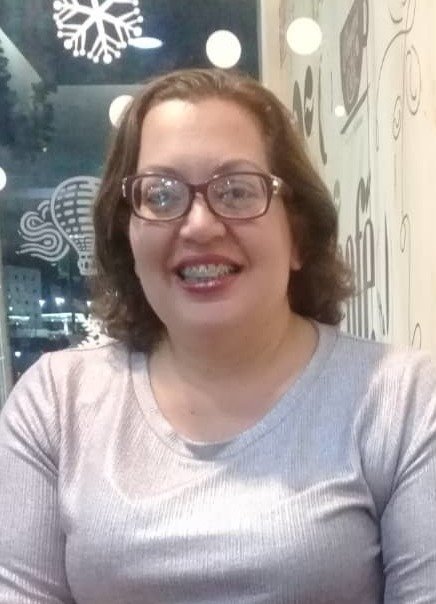
Economist (Central University of Venezuela). Full professor and researcher attached to the “Edgar Abreu Olivo” Agrifood Research Center, Universidad de Los Andes. Doctor from the University of La Laguna (Spain). Award “One of the 10 most consulted authors of the Saber ULA university portal” (2005); prize in the III Essay Contest of the Central Bank of Venezuela BCvoz Economico, 2016, with the work “Theobroma cacao: transformation and consumption of the “food of the gods” in Venezuela and the world” (co-authored).
This post is also available in:
![]() Español (Spanish)
Español (Spanish)
